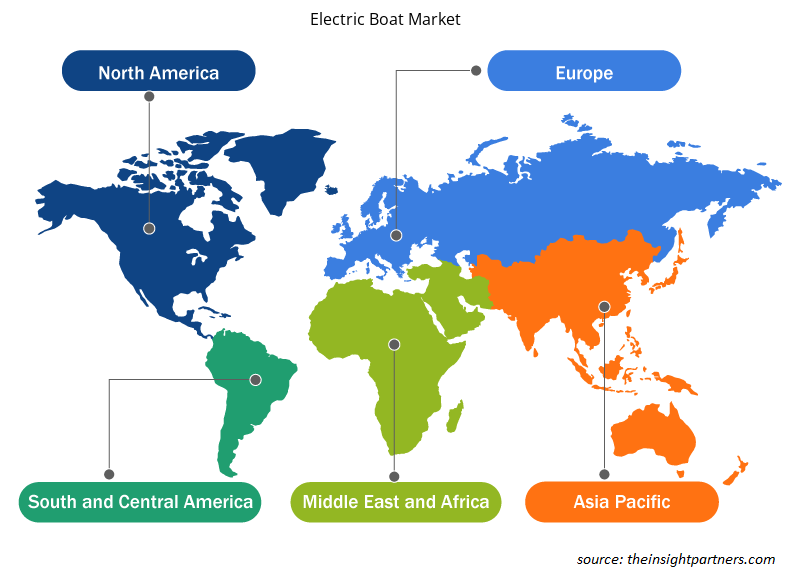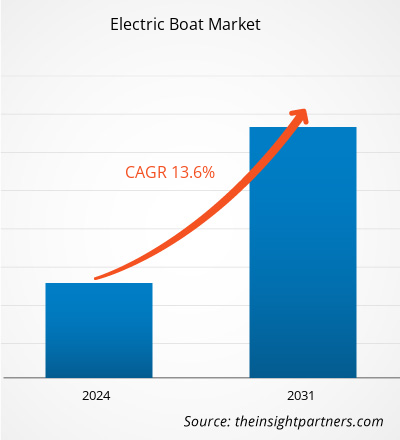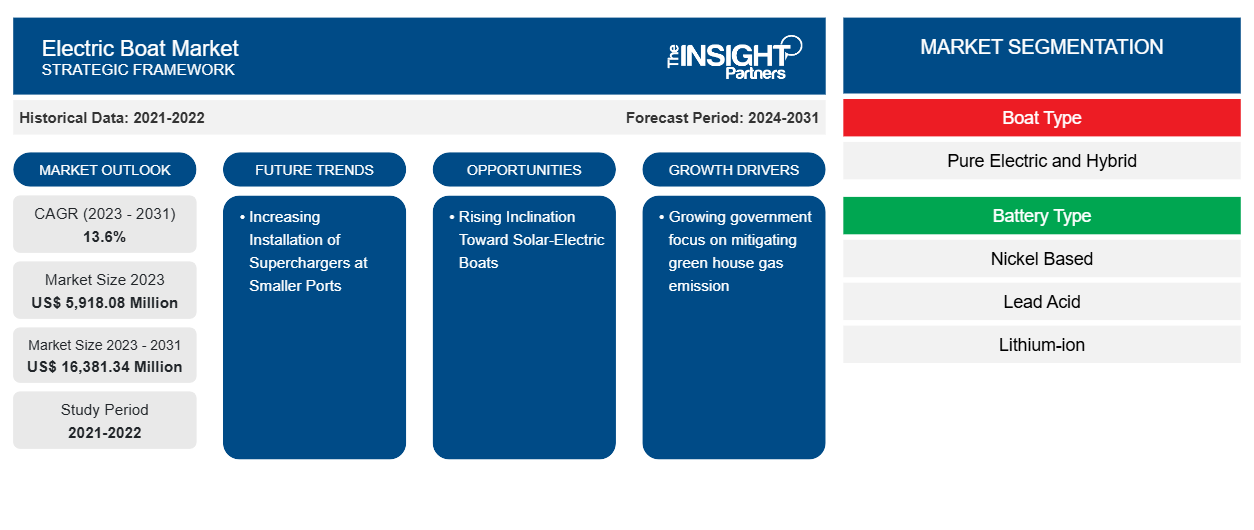Se proyecta que el tamaño del mercado de embarcaciones eléctricas alcance los 16.381,34 millones de dólares en 2031, frente a los 5.918,08 millones de dólares en 2023. Se espera que el mercado registre una CAGR del 13,6 % durante el período 2023-2031. Es probable que la creciente instalación de supercargadores en puertos más pequeños siga siendo una tendencia clave en el mercado.CAGR of 13.6% during 2023–2031. The increasing installation of superchargers at smaller ports is likely to remain a key trend in the market.
Análisis del mercado de barcos eléctricos
Las empresas de barcos eléctricos se centran cada vez más en mejorar la eficiencia y la autonomía de las baterías mediante la mejora de la infraestructura de carga. La presencia de un gran número de fabricantes de barcos eléctricos compite a gran escala, principalmente en función de la tecnología de carga (características) y la disponibilidad de presencia en todo el mundo. Entre ellos se incluyen Candela, Frauscher, Duffy Electric Boat Company y otros actores.growingly focusing on improving battery efficiencies and range by enhancing charging infrastructure. The presence of a large number of electric boat manufacturers is competing at a large scale primarily based on charging technology (features) and availability of presence across the globe. It includes Candela, Frauscher, Duffy Electric Boat company and other players.
Panorama del mercado de embarcaciones eléctricas
Los principales actores en el ecosistema del mercado global de barcos eléctricos incluyen proveedores de materias primas, proveedores de componentes y clientes o usuarios finales. El proveedor de materias primas es un actor crucial en el ecosistema del mercado de barcos eléctricos. Las partes principales de un barco eléctrico incluyen plástico, acero, aluminio, madera, caucho y otras partes. Los proveedores de componentes incluyen fabricantes de barcos de piezas marinas y proveedores de cargadores. Los principales usuarios finales que demandan barcos eléctricos son los propietarios de barcos y los proveedores de servicios de alquiler de barcos. Los principales proveedores de materias primas incluyen Duffy Electric Boat Company, Evoy, RAND Boats y otros actores.
Personalice este informe según sus necesidades
Obtendrá personalización en cualquier informe, sin cargo, incluidas partes de este informe o análisis a nivel de país, paquete de datos de Excel, así como también grandes ofertas y descuentos para empresas emergentes y universidades.
- Obtenga las principales tendencias clave del mercado de este informe.Esta muestra GRATUITA incluirá análisis de datos, desde tendencias del mercado hasta estimaciones y pronósticos.
Factores impulsores y oportunidades del mercado de embarcaciones eléctricas
El creciente enfoque del gobierno en la mitigación de las emisiones de gases de efecto invernadero favorece el mercado
La creciente contaminación ambiental causada por los combustibles fósiles es una de las principales preocupaciones de los gobiernos. Para reducir el nivel de contaminación ambiental, varios gobiernos están haciendo hincapié en que los consumidores adopten alternativas más limpias, sostenibles y respetuosas con el medio ambiente mediante la concesión de descuentos especiales en las ventas, incentivos, ofertas lucrativas y beneficios fiscales. China, Japón, la Unión Europea, India, Canadá y Corea del Sur son algunas de las principales geografías en las que los gobiernos están trabajando activamente para impulsar la adopción de embarcaciones eléctricas, lo que se prevé que impulse la evolución del mercado de embarcaciones eléctricas durante el período previsto. El creciente enfoque en la mitigación de las emisiones de gases de efecto invernadero también está actuando como un importante motor de crecimiento para el mercado de embarcaciones eléctricas a nivel mundial.
Creciente inclinación hacia los barcos eléctricos solares
Las embarcaciones solares eléctricas tienen varias ventajas, entre ellas, la necesidad de un mantenimiento reducido debido a que no es necesario cambiar el impulsor de aceite ni alterar el filtro diésel, menos vibraciones, un buen ahorro de combustible, la prevención de la contaminación local y una reducción del peso total de las embarcaciones. La energía solar ayuda a controlar el flujo de electricidad a las baterías recargables, como las de iones de litio . Además, las embarcaciones solares eléctricas pueden funcionar con bajos gastos operativos, lo que las convierte en la opción preferida por los usuarios en comparación con las embarcaciones a combustible, en las que existe una gran necesidad de mantenimiento regular. Se prevé que estas ventajas refuercen la demanda de embarcaciones solares eléctricas en los próximos años.
Informe de análisis de segmentación del mercado de barcos eléctricos
Los segmentos clave que contribuyeron a la derivación del análisis del mercado de embarcaciones eléctricas son el tipo de embarcación, el tipo de batería y la aplicación.
- Según el tipo de embarcación, el mercado de embarcaciones eléctricas se divide en eléctricas puras e híbridas. El segmento de las eléctricas puras tuvo una mayor participación de mercado en 2023.
- Según el tipo de batería, el mercado de embarcaciones eléctricas se divide en baterías de níquel, de plomo-ácido y de iones de litio. El segmento de iones de litio tuvo una mayor participación de mercado en 2023.
- Según la aplicación, el mercado de embarcaciones eléctricas se divide en pesca, recreativo y otros. El segmento recreativo tuvo una mayor participación de mercado en 2023.
Análisis de la cuota de mercado de embarcaciones eléctricas por geografía
El alcance geográfico del informe del mercado de barcos eléctricos se divide principalmente en cinco regiones: América del Norte, Asia Pacífico, Europa, Medio Oriente y África, y América del Sur y Central.
El alcance del informe del mercado de embarcaciones eléctricas abarca América del Norte (EE. UU., Canadá y México), Europa (Rusia, Reino Unido, Francia, Alemania, Italia y el resto de Europa), Asia Pacífico (Corea del Sur, India, Australia, Japón, China y el resto de Asia Pacífico), Oriente Medio y África (Arabia Saudita, Sudáfrica, Emiratos Árabes Unidos y el resto de Oriente Medio y África) y América del Sur y Central (Argentina, Brasil y el resto de América del Sur y Central). En términos de ingresos, América del Norte dominó la participación de mercado de embarcaciones eléctricas en 2023. Europa es el segundo mayor contribuyente al mercado mundial de embarcaciones eléctricas, seguida de Asia Pacífico.UAE, and the Rest of Middle East & Africa), and South & Central America (Argentina, Brazil, and the Rest of South & Central America). In terms of revenue, North America dominated the electric boat market share in 2023. Europe is the second-largest contributor to the global electric boat market, followed by Asia Pacific.
Perspectivas regionales del mercado de embarcaciones eléctricas
Los analistas de Insight Partners explicaron en detalle las tendencias y los factores regionales que influyen en el mercado de embarcaciones eléctricas durante el período de pronóstico. Esta sección también analiza los segmentos y la geografía del mercado de embarcaciones eléctricas en América del Norte, Europa, Asia Pacífico, Oriente Medio y África, y América del Sur y Central.

- Obtenga los datos regionales específicos para el mercado de embarcaciones eléctricas
Alcance del informe sobre el mercado de embarcaciones eléctricas
| Atributo del informe | Detalles |
|---|---|
| Tamaño del mercado en 2023 | US$ 5.918,08 millones |
| Tamaño del mercado en 2031 | US$ 16.381,34 millones |
| CAGR global (2023 - 2031) | 13,6% |
| Datos históricos | 2021-2022 |
| Período de pronóstico | 2024-2031 |
| Segmentos cubiertos | Por tipo de embarcación
|
| Regiones y países cubiertos | América del norte
|
| Líderes del mercado y perfiles de empresas clave |
|
Densidad de actores del mercado de embarcaciones eléctricas: comprensión de su impacto en la dinámica empresarial
El mercado de barcos eléctricos está creciendo rápidamente, impulsado por la creciente demanda de los usuarios finales debido a factores como la evolución de las preferencias de los consumidores, los avances tecnológicos y una mayor conciencia de los beneficios del producto. A medida que aumenta la demanda, las empresas amplían sus ofertas, innovan para satisfacer las necesidades de los consumidores y aprovechan las tendencias emergentes, lo que impulsa aún más el crecimiento del mercado.
La densidad de actores del mercado se refiere a la distribución de las empresas o firmas que operan dentro de un mercado o industria en particular. Indica cuántos competidores (actores del mercado) están presentes en un espacio de mercado determinado en relación con su tamaño o valor total de mercado.
Las principales empresas que operan en el mercado de embarcaciones eléctricas son:
- Frauscher Bootswerft GmbH & Co KG
- Compañía de barcos eléctricos Duffy
- Barcos Rand A/S
- Tecnologías marinas de visión inc.
- Puerta cuadrifolio
- Manualidades con madera de Budsin
Descargo de responsabilidad : Las empresas enumeradas anteriormente no están clasificadas en ningún orden particular.

- Obtenga una descripción general de los principales actores clave del mercado de barcos eléctricos
Noticias y desarrollos recientes del mercado de embarcaciones eléctricas
El mercado de embarcaciones eléctricas se evalúa mediante la recopilación de datos cualitativos y cuantitativos a partir de una investigación primaria y secundaria, que incluye publicaciones corporativas importantes, datos de asociaciones y bases de datos. A continuación, se enumeran algunos de los avances en el mercado de embarcaciones eléctricas:
- El constructor de barcos danés Rand Boats A/S ha presentado una nueva embarcación eléctrica denominada Spirit 25, también disponible en una versión a gasolina. (Fuente: Rand Boats A/S, comunicado de prensa, marzo de 2022)
- Groupe Beneteau se ha asociado con Vision Marine Technologies para desarrollar embarcaciones totalmente eléctricas equipadas con motores fueraborda. (Fuente: Vision Marine Technologies, comunicado de prensa, julio de 2022)
Informe sobre el mercado de embarcaciones eléctricas: cobertura y resultados
El informe “Tamaño y pronóstico del mercado de embarcaciones eléctricas (2021-2031)” proporciona un análisis detallado del mercado que cubre las siguientes áreas:
- Tamaño del mercado de embarcaciones eléctricas y pronóstico a nivel global, regional y nacional para todos los segmentos clave del mercado cubiertos bajo el alcance
- Tendencias del mercado de embarcaciones eléctricas, así como dinámicas del mercado, como impulsores, restricciones y oportunidades clave
- Análisis PEST y FODA detallados
- Análisis del mercado de embarcaciones eléctricas que cubre las tendencias clave del mercado, el marco global y regional, los principales actores, las regulaciones y los desarrollos recientes del mercado.
- Análisis del panorama de la industria y de la competencia que abarca la concentración del mercado, el análisis de mapas de calor, los actores destacados y los desarrollos recientes del mercado de embarcaciones eléctricas
- Perfiles detallados de empresas
- Análisis histórico (2 años), año base, pronóstico (7 años) con CAGR
- Análisis PEST y FODA
- Tamaño del mercado, valor/volumen: global, regional y nacional
- Industria y panorama competitivo
- Conjunto de datos de Excel
Informes recientes
Informes relacionados
Testimonios
Razón para comprar
- Toma de decisiones informada
- Comprensión de la dinámica del mercado
- Análisis competitivo
- Información sobre clientes
- Pronósticos del mercado
- Mitigación de riesgos
- Planificación estratégica
- Justificación de la inversión
- Identificación de mercados emergentes
- Mejora de las estrategias de marketing
- Impulso de la eficiencia operativa
- Alineación con las tendencias regulatorias























 Obtenga una muestra gratuita para - Mercado de barcos eléctricos
Obtenga una muestra gratuita para - Mercado de barcos eléctricos